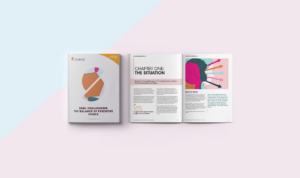Women in Technology
Our clients are continually asking us to introduce them to the very best diverse candidates – and within technology, the focus is firmly on senior female leaders. We fully expect now to provide gender-balanced longlists and shortlists and last year 37% of our placements were women. We are constantly thinking about new ways to uncover female talent and to encourage women to think strategically about developing their careers. We spend much of our time networking and mapping the market for great female technology leaders and to ensure that we can present our clients with the highest calibre individuals in the market.
Why do clients value diversity?
Most organisations now understand that having a diverse work force and leadership team that reflects its customer base will be more creative, delivering new and different products and solutions. Having a variety of opinions will certainly lead to innovation and will stop the twin curses of group think and the echo chamber.
Developing the greatest talent within an organisation can only lead to the creation of greater business value. Focusing on diversity just to box tick won’t get you very far, but an authentic, full-hearted commitment at the most senior levels of leadership will reap significant benefits for your company.
Why is it so difficult?
Figures from the Office of National Statistics show that only 17% of IT professionals are women and that this figure has not changed over the last decade. By contrast, in the same period, the number of women in engineering has doubled to 50,000. Why is this?
Firstly, it is clear that there are serious misconceptions as to the kind of roles there are available under the technology umbrella. It is true to say that in our long careers, this is absolutely the most exciting time to be working in this area. The ability of technology to impact and transform businesses and the way people behave is unprecedented. We took a look at the Technology GCSE syllabus of one of the major examination boards and was disappointed to see that there was little to enthuse anyone who is interested in how people relate to each other, how organisations can succeed, how innovation can be harnessed and how the world is going to look very different in even a year from now. Tech roles do not only include coders, systems analysts and infrastructure directors.
Where are the senior females in technology that girls and young women can role model themselves on? There are very few. Rather, our perceptions of working in technology are coloured by bro-cultures of Silicon Valley and tech clusters with casual sexism and out-dated bias. The behaviour of some very successful entrepreneurs, no matter how innovative they have been, is deeply unattractive to women, and does little to make them feel welcome in the industry.
What do women want?
A survey by the Centre for Creative Leadership (CCL) asked 500 senior female leaders why they stayed with their employer. The resulting narrative revolved around working for an organisation with values and purpose, being able to make a difference and having a work/life balance. Pay and benefits came fourth. Flexibility was important as was leadership development.
From our own observations taken from the hundreds of search interviews and career development conversations we have had with women, we can see that women leaders (and of course many men) prefer roles and companies where there is a positive inclusive culture with a shared purpose, unhampered by politics and posturing, where it is possible to get things delivered in a quality way and where there is a key alignment with delivering benefit and where the management style is empathetic, keen to develop talent and fair.
Given that the pool of senior women in technology is so small (far less than 17% at the most senior levels) and that it is therefore a seller’s market, it is worth taking note of what women are saying if you are hoping to attract them into your organisation.
What can organisations do?
Although much is out of our hands (the development of GCSE and A level syllabi and the distastefulness of some of the behaviours and culture of Silicon Valley), there are steps that organisations can take to ensure they stand the highest chance of hiring and retaining female talent. Here is the advice and guidance we as headhunters would respectfully give. The first and most critical thing is to ensure that there is genuine leadership and a vocal commitment to diversity right from the top. Make sure the issue is addressed in your annual reports, ensure your executive leaders mention the commitment at any opportunity. If you build your reputation on your aims and objectives, it will be noticed. Make sure everyone in your firm understands why it matters to you.
Get the proposition right
Ensure that, in all your messaging around your employer brand, women at all levels are featured, it doesn’t matter in what positions. Show women doing interesting roles and that they can combine that with balancing life commitments and interests. Demonstrate that their personal values can align with the business’s objectives. Show that with commitment and contribution their careers can be developed in surprising and interesting ways. Make it clear that as an organisation you recognise the value of an inclusive, innovative culture. This will also be appreciated by many men too, of course, and can only be additive to your brand.
More specifically…
So, you are a CIO/CTO/CDO and you now have the opportunity to make a senior hire. How can you give yourself the best possible chance of hiring a talented woman?
First, think about the absolute must haves for the role you are considering, what is the MPV (the minimum viable product). Very often, in many senior roles, particularly where you’re considering potential succession, amongst the most important requirements are leadership, sophisticated stakeholder management skills, ability to deliver business benefit and commercial acuity, all combined with a large dollop of EQ. These strengths are very often well-developed in women. At these levels, technical wizardry may well not be so important, perhaps what is required can be buttressed at lower levels, so think carefully about what it is you really need.
When you come to write your job spec, put yourself in the shoes of someone who may have prime caring responsibilities and who may well not wish to undertake a lengthy weekly commute (not many women do). How many days must they absolutely be in the office; how well are you set up for virtual teams and working effectively from home (our views on this have surely changed given the current pandemic); is there a choice of locations?
Make sure you dwell on how this role will play its part in accomplishing the mission of the company and what the culture and values are. A long list of technical requirements is a turn off. If you ask for a technical skill a woman doesn’t have, she simply won’t apply. A job spec is a selling document. Talented women are now in the driving seat; it’s a seller’s market, so you need to work hard to attract them. A key element of the Savannah service is to help you shape and articulate your proposition to make it attractive to women.
At interview
Likewise, an interview is a two way sell, not just an opportunity for you to decide on whether to offer your female candidate a position, only for her to turn you down. It is likely that if she is talking to you, she is talking to others. Women have often told us that they see their work as an extension of their lives; they want to have a purpose and not just be able to pay the mortgage. Tell them the story of your organisation and why it would be a great place for them. Tell them how it will enable them to grow personally and professionally: mention your mentoring scheme, talk through where their career might take them. Get them inspired as to how their lives will be better by working for you. And after you have made the offer, and they have accepted, stay in touch over their notice period (their current employer may well be trying to buy them back – you need them to switch their emotional allegiance and loyalty to you), keep in touch, update them with key information, perhaps include them in a drink with the team.
Be realistic
Remember the pool of female talent is small and is in high demand. There are some roles where there are more women than others. Sadly, there are still not yet many female architects, data scientists or CISOs, but there are a good number of fine programme directors, business partners, and CIOs, for example. Even if you are focusing on gender diversity, you should not compromise the quality bar in your tech organisation. Hire where the talent is and focus on developing in house capability in these more difficult roles. Each time you are able to hire, consider whether it could be an opportunity for diversity, but recognise that it cannot be a blanket requirement.
An excellent way to test the waters before committing to a full search is to commission a mapping exercise. Savannah regularly conducts these to see whether the goal of placing a female in a particular role is viable. We identify every single appropriate female in the market (geographic and function), and our clients then have certainty that if they wish to hire a woman, she will be included in that exercise. Mappings can be undertaken at varying levels of detail (and cost), from a simple list of LinkedIn profiles to a very detailed document covering career trajectory, salary details etc. This is particularly important to ensure your compensation packages are at the right level or to support succession planning, or to build new talent pools.
That confidence thing
Over our many years in this business, we have recognised that women are less likely to sell their skills hard and are more likely to highlight any areas of weakness they might have as they measure themselves against the spec. They want to be absolutely clear where they might fail and where there might be more apparently qualified candidates. Men are much less likely to do this; if they can tick six out of ten of the requirements, they will apply; women often need to tick ten out of ten. Of course, it’s the same when it comes to asking for promotion or for a pay rise. Women often hope that if they work hard, they will be recognised – and often they aren’t.
Similarly, women often enjoy giving credit to others in the team and will talk more “we” than “I”. Interestingly, it’s the other way round with men. When interviewing you will need to probe more deeply as to who actually did what. You will need to adapt your interviewing style and perhaps adjust your preconceptions about what good leadership looks like. It may well be that a more sophisticated and nuanced style will have greater impact and deliver more business benefit than the traditional gung-ho, command and control techniques.
She’s arrived!
Congratulations, you’ve done all the right things and your talented female high potential or leader has joined your team. How can you help them to achieve their full potential as quickly as possible? It’s particularly appropriate if you can, that they are welcomed and inducted by other women, in order to promote a sense of belonging and support. Do you have any in-house women’s networks they could join? We can introduce you to any number of people who have started these, if needed.
Find your new recruit a female mentor from within your organisation. All eyes may well be on her, particularly if there is any sense that she has been hired purely for her gender. A supportive, more senior female who can help her through the cultural and political complexities will be invaluable. In addition, you might want to consider an onboarding programme which will help accelerate her transition providing greater value to the individual, and the business in both the short and long term.
In the longer term
So, you’ve got a good supply chain of women coming through, who you have brought in on your graduate programme and who never thought that they’d end up working in technology but are now loving the contribution they can make. They’ve made it to middle management level. How do you retain them and encourage them to reach executive level? Many talented women leave employment when they have their second child as their lives become more complicated. Have you thought about maternity support and a return to work scheme to encourage them back after you have sensitively stayed in touch over the three-five years they have taken out? Can you invest in continuing professional development activities; ask them if they’d like to get involved in key projects as an interim, perhaps.
But most importantly, the key thing is to shout from the roof tops at any opportunity that the values and culture of your organisation and the opportunities it can give women (and men) to have interesting and purposeful roles are absolutely second to none!
Good luck!
What is Savannah doing to improve gender diversity in its clients’ technology organisations?
Our personal commitment to identifying and support female talent has led to Savannah consistently delivering 50/50 gender diverse shortlists and 37% of our placements have been female.
Amongst our services and initiatives are:
Gender Mapping
We provide full mappings of female talent in specific sectors and job functions to make sure every single potential female candidate has been identified.
Gender Balance Breakfasts for Senior Technology Leaders
Savannah runs quarterly “attaining gender balance” breakfasts for female CIOs and CDOs which have been hosted by the Global CIOs of major organisations, including Unilever, BAT, News International. BP and Harper Collins. We share ideas on how to attract and retain women in technology and discuss what has worked well and what hasn’t.
Female Technology Talent Exchange
Building on from the Gender Balance Breakfasts, the network has created Europe’s only female technology talent exchange programme and, supported by Savannah, Unilever and Dell are piloting a scheme to second high potential females into another organisation for a period to learn new ways of thinking and working which they can bring back to their own company.
Savannah’s CIO Mentoring Scheme for Senior Technology Leaders
Over 120 of the world’s top CIOs, including many female CIOs act as mentors for us to high potential, up and coming technology leaders in Savannah’s unique mentoring scheme. This has proven to be particularity successful with female talent.
Virtual Onboarding Programme
In partnership with Genesis and Michael Watkins, renowned author of The First 90 Days and Master Your Next Move, Savannah’s on-boarding offering can help accelerate transitions to ensure that new hires or internal moves and promotions are supported and able to ‘hit the ground running’ providing greater value for the individual, teams and the overall business.
Gender Board Reports
Whilst not focused exclusively on the technology sector, Savannah produces quarterly and annual reports analysing the Gender Balance on FTSE 350 Boards.
We would love to tell you more, please get in touch.




